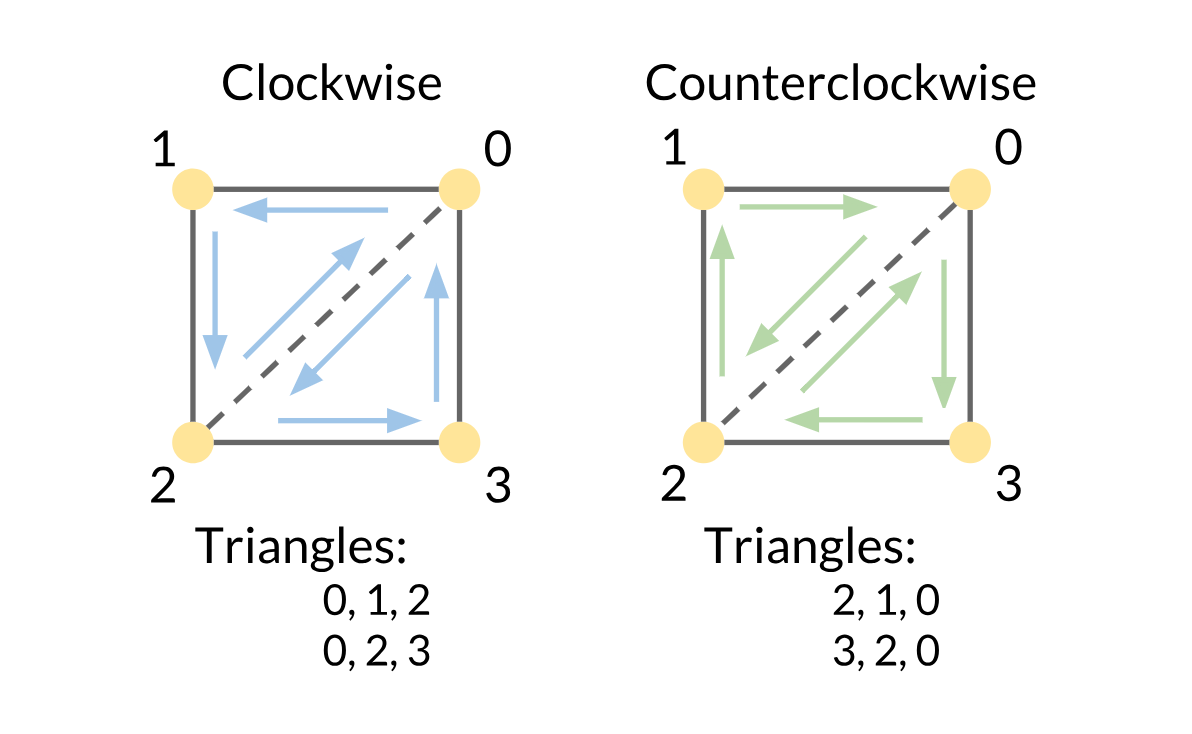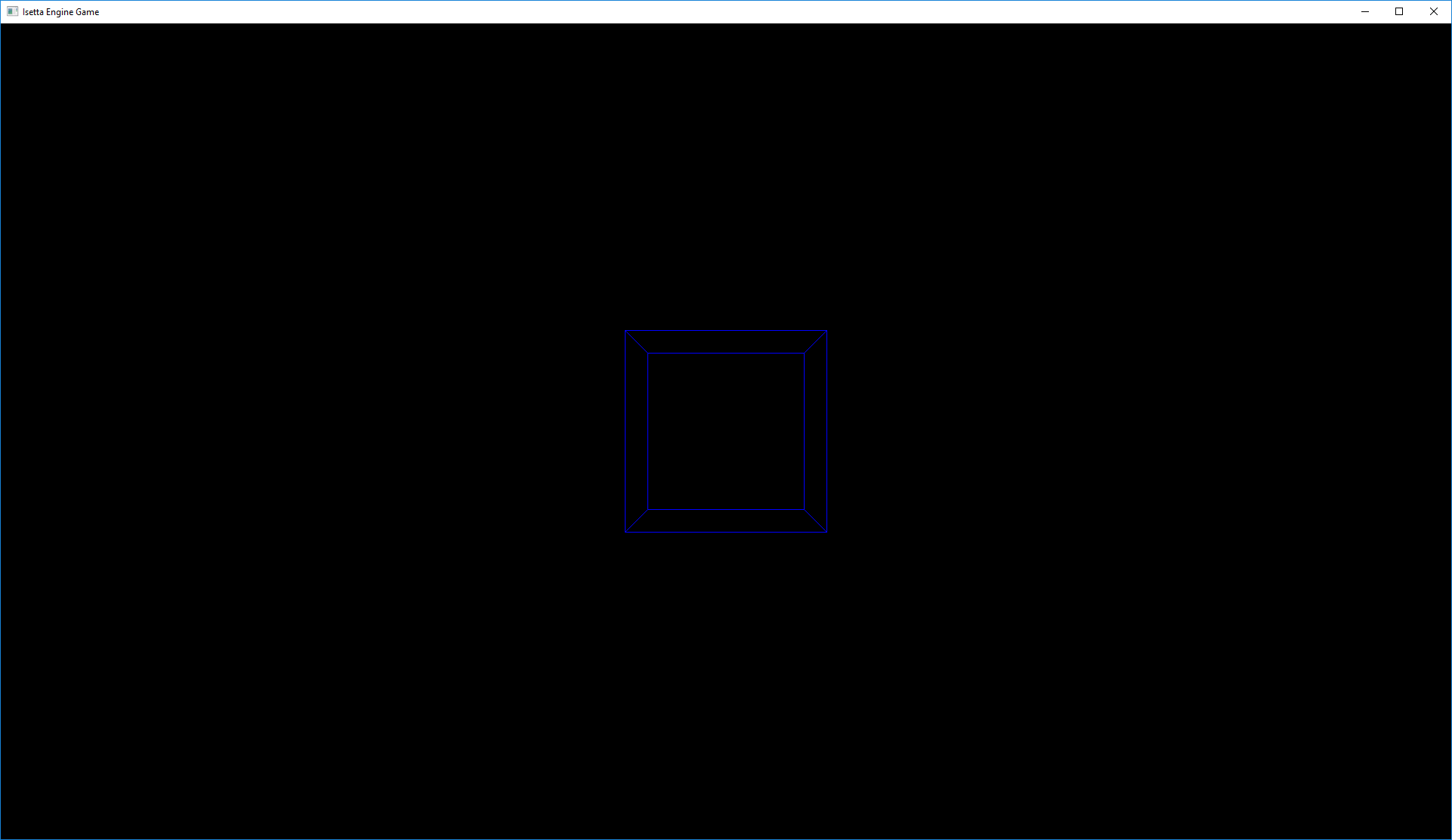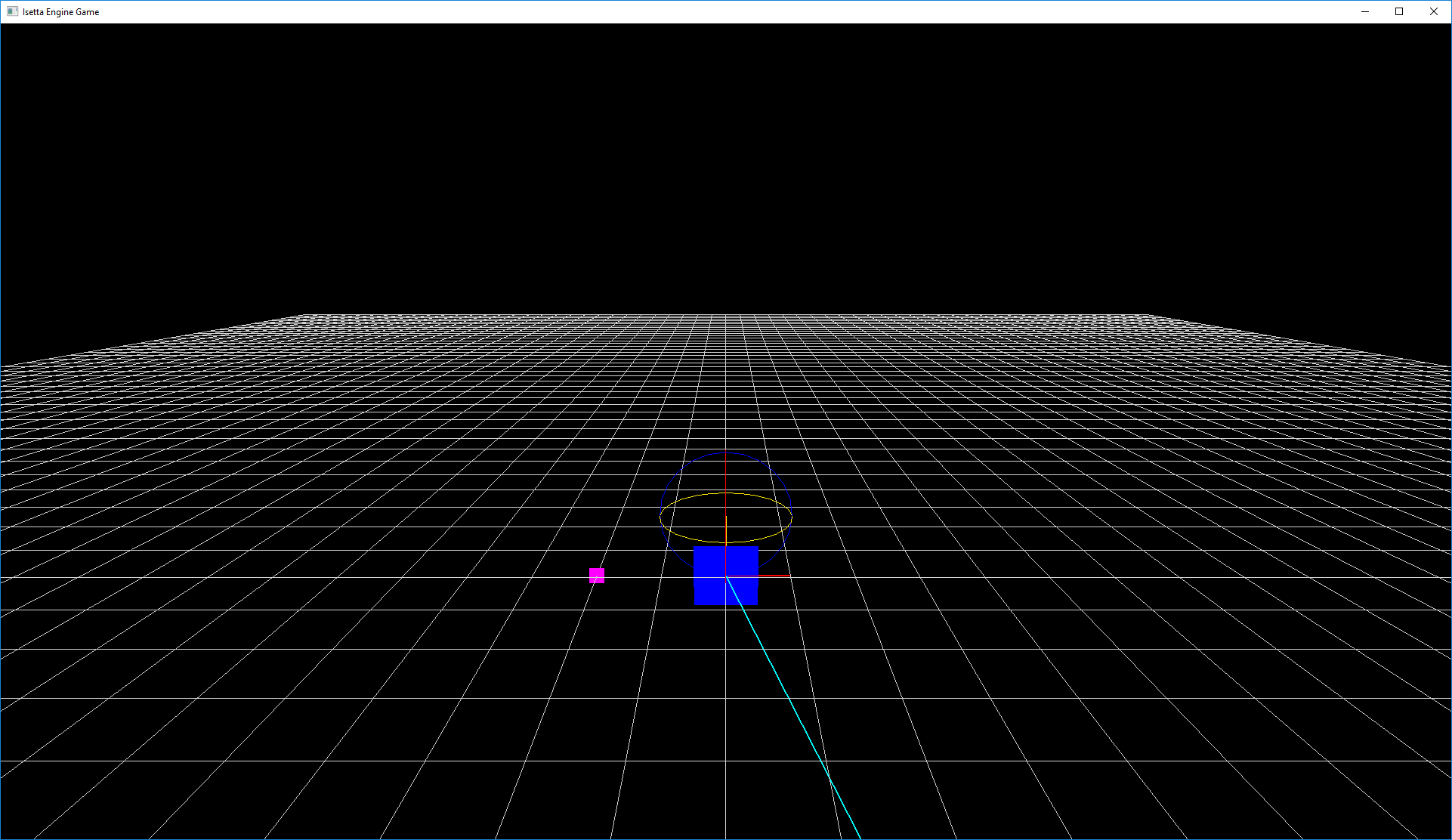I Think It's Playable¶
Byte-Sized Updates¶
- Debug Drawing: Implemented our entire visual debug drawing system, which has already revealed a mistake!
- Level (Scene Graph): Designed the scene graph architecture as Level-Entity-Component, and created a reflection system for loading user-defined levels.
- Transform: Began development on our transform hierarchy, and implemented some gameplay features with it like a flyby camera.
- DLL: The engine was built into a DLL (well, sort of), and we were able to run the engine in another project.
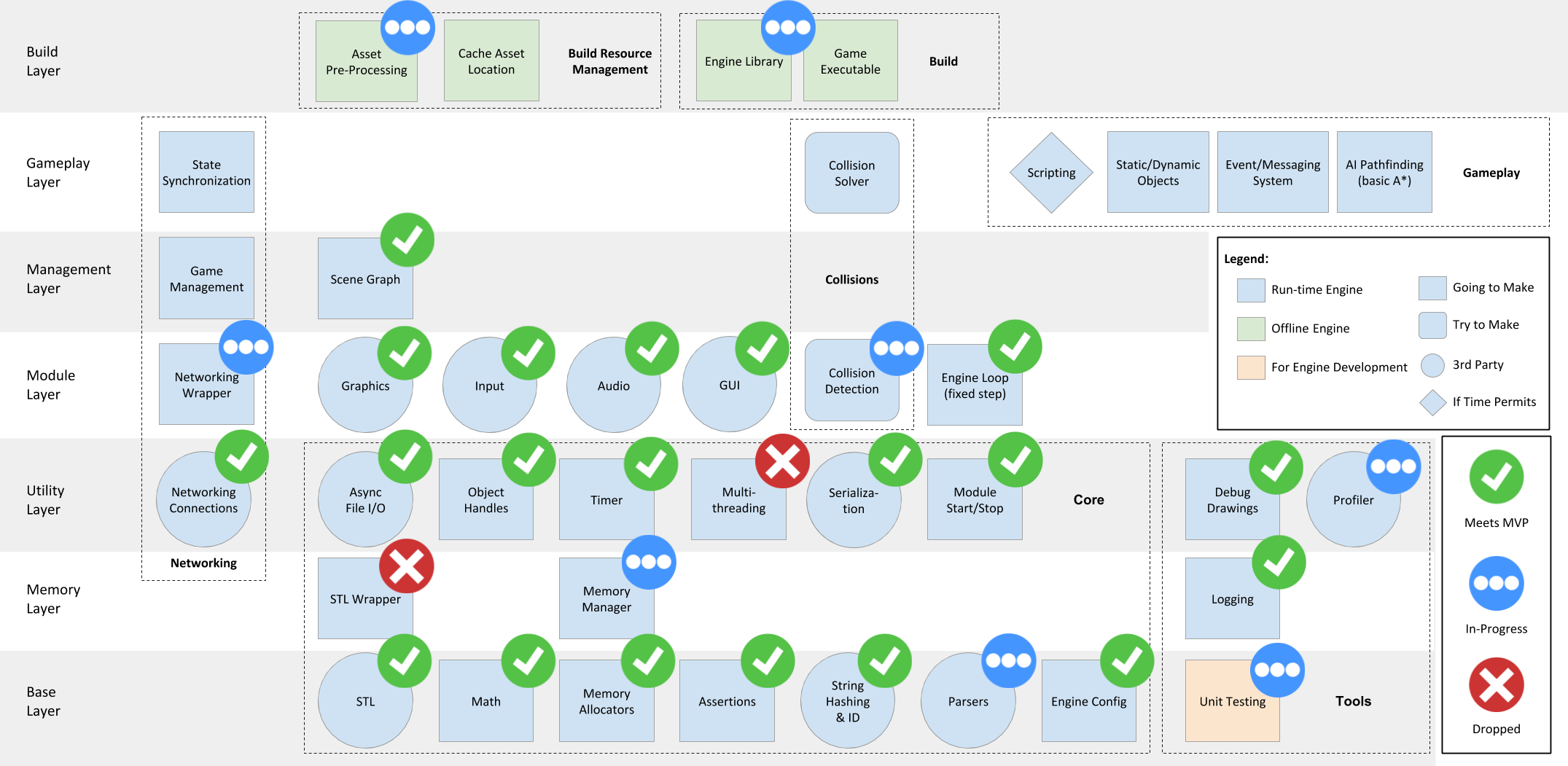
Debug Drawing¶
Debug drawing is the visual equivalent to a print statement, and it is a good immediate check on whether a system you've programmed "looks" right. It is much easier to debug something through drawing than it is through text output; in fact, it even helped us discover a problem with our assets! (We'll cover this in a bit)
What we want is some primitive types: lines, rays, planes, cubes, and spheres. We initially looked into Horde3D's capabilities for drawing these primitives, but we thought it made no sense to import models for these simple drawings—how would we even render a line model?! As in the past weeks, Horde3D's lightweightedness gave us no immediate way of doing this. The Horde forums offered solutions for generating procedural geometry and using OpenGL1 with Qt2, but they each had their own flaws, either using legacy functionality or bringing in libraries that mostly replicate our existing libraries. What we really wanted was to be able to write raw OpenGL code.
Foray into OpenGL¶
Getting OpenGL working with Horde required a decent understanding of Horde's render loop. Firstly, any OpenGL drawing needs to happen after Horde's h3dRender and h3dFinalizeFrame. In h3dRender, 'glClear' is called to blank the screen (clearing any drawings done prior to the functions), and between these two functions, OpenGL's state is being changed, and any changes between the two function calls could tamper with Horde's rendering. To begin using OpenGL, we followed some simple OpenGL tutorials on setting up a camera, viewport3, and rendering to the screen using vertex arrays and buffers4. This was done in isolation of the engine project as a primer to the updated OpenGL4.0. When bringing this into our engine, we removed the RenderModule and GUIModule's StartUp, Update, and ShutDown so the only class utilizing OpenGL would our new system. With only the new system calling OpenGL code, we were able to get a triangle rendered in screen space in our engine relatively quickly. And it looks magnificent!
Well, it's a start. From there, we implemented the element buffer5 so that we could reuse the vertices, because although we are generating simple primitives, we want 2 versions: a solid and a wireframe. An element buffer allows us to avoid creating different lists of vertices for our primitives because we can just specify the ordering in which the same vertices are used to draw the primitive. The order of the vertices is particularly important for solid objects because it determines which "side" of the primitive is drawn, one of which is typically invisible! This vertex order can be clockwise or counterclockwise, so it's known as the winding order (kind of like how you wind a toy).
With an understanding of OpenGL 4.0, proof that it was working in our solution, and a triangle in hand, we decided to break everything by reintroducing the RenderModule but not the GUIModule just yet—we aren't that crazy! The reason to remove GUI to begin with was because it has OpenGL calls which could change the OpenGL state. We wanted to ensure the only system interfacing with OpenGL was DebugDraw. Although GUI happens after the DebugDraw, so the debug drawings don't appear over the UI, it was reintroduced to keep the errors only associated with debug drawer and not possible integration bugs. As you'd expect if you've done graphics work before, the screen was black, and our triangle was totally gone. After rigorous debugging (i.e. commenting things out to determine the source of the problem), we figured out that the element buffer was the source of the problem! The vertex buffer was able to render both wireframes and solid primitives, but the element buffer only rendered wireframes, as with the quad:
Initially, we thought we didn't need the element buffer for debug drawing because it was so simple. However, being engineers, we also had the frustration of not knowing why it didn't work. After hours of more debugging, the answer was relatively simple: a reversed winding order. Rather than using the same winding order that the OpenGL test scene was using (clockwise), Horde had a reversed winding order (counterclockwise). So really, the back of the object was being "rendered", which actually means it was culled6 instead of drawn! From here, implementing all the debug drawing just required accurate counting of vertex indices and lots of hand-drawn pictures with counter-clockwise swirls on the shapes.
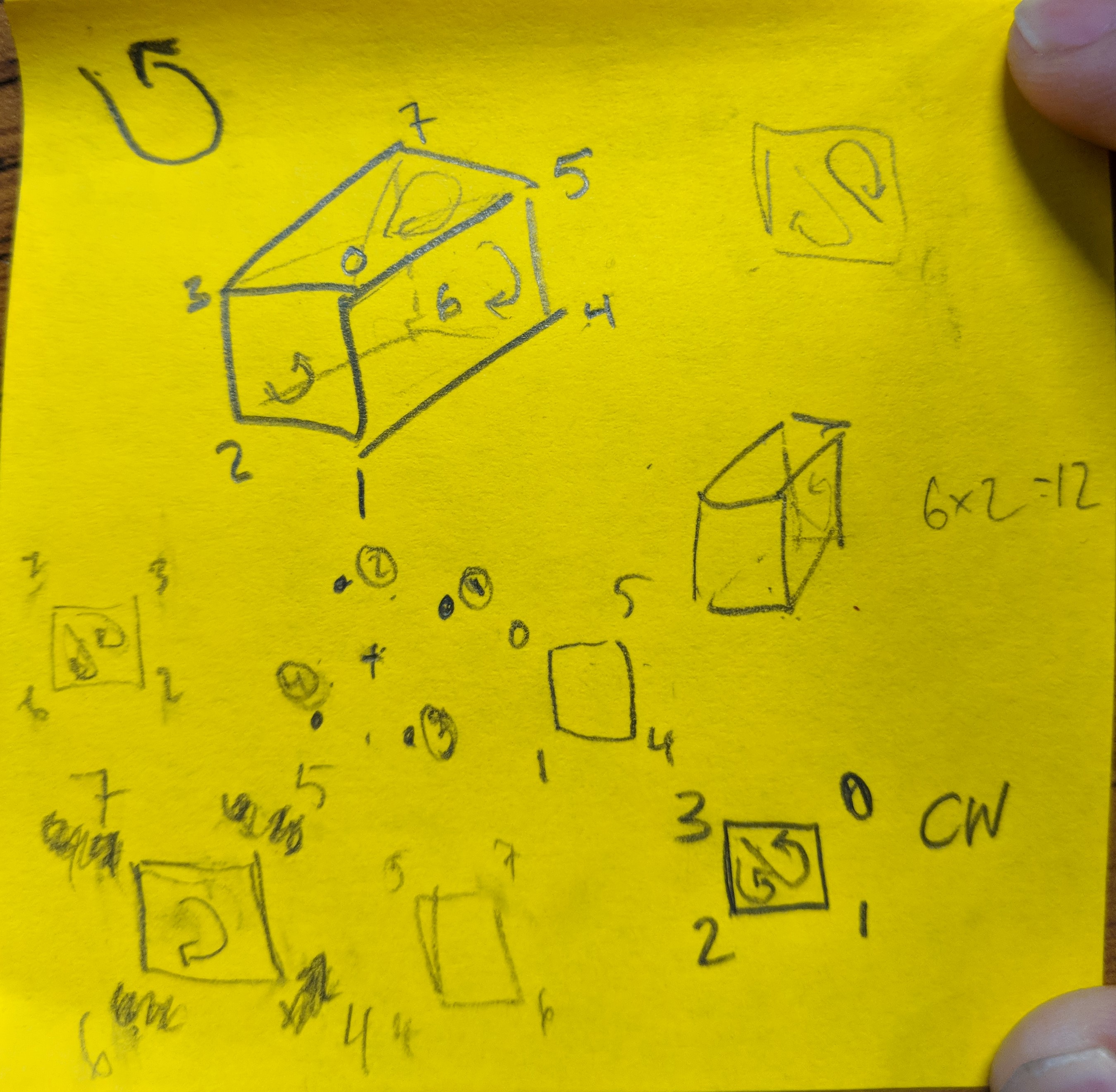
Our next problem was rendering things beyond the screen, in the 3D world. With our modest understanding of graphics, we knew we needed a model-view matrix7 to translate the drawings. But before we got to that, we recognized that our row-major15 array order could cause a problem because OpenGL is column-major15 (which can be less intuitive initially to think about) and programmers typically create arrays as [row][column]. Looking at our Matrix4 class, we had done just that. This fix is to transpose8 the matrix when we pass our information to OpenGL or Horde—and we dodged a major bullet by figuring that out first!
The drawings were now being placed at the right position (well, it was fairly hard to tell with not much of a frame of reference. Oh, the woes of initial graphics!). However, the squares on screen then became oddly rectangular, and by that we mean they were rectangles and not squares. The vertex positions are hardcoded, so we did a quick sanity check against the numbers and found that we do indeed have the vertices for a unit plane/cube. However, to move the hardcoded drawings throughout the scene, the vertex positions are shifted via a vertex shader9. The shader multiplies the vertex's homogenous10 position with the object's local to world matrix, known as the model matrix, which allows the developer to specify position, rotation and scale. Then the shader multiplies the resultant Vector4by the view matrix (that is, the position, rotation, and scale) of the camera. What was missing was the projection matrix, the matrix that defines the camera's frustum11 and thus what the camera sees. This fix was as simple as grabbing the projection matrix from Horde (set by us on when initializing the camera) and passing it into the shader. The rectangle became square and is now positioned in the 3D world, rather than directly on the 2D screen!
Model Asset Pipeline¶
The rendering of the debug objects was nearing completion, but when the RenderModule reintroduced the "pushing man" animated model back to our scene, it gave us some pause. The camera had been put out at Z=600 and the man at Z=-100 just so that the man was properly rendered on the screen. Our initial thought was the model had an offset pivot12, so we imported him into Maya to check, but the pivot seemed okay. Luckily, we were smart enough to import him into Unity and compared him with a cube— and turns out, he was massive! Pulling in an experienced artist to help us shrink the model without breaking the rig and animation, we were eventually able to export him at an appropriate scale (closer to the size of a unit cube and not a skyscraper). This also re-exposed us to our asset pipeline that requires the models to be pre-processed by Horde into .geo13 models, which we expedited with a batch script. We brought the "normal"-sized man back into the scene and compared him to the other sized model we had originally:
The one on the left is actually the giant, because he was pushed out to Z=-600, the camera is at Z=2, and the new model at Z=0. The fact that the left model is visible at that distance depicts how large it really was. And so, our debug drawing was already proving to be valuable, as that problem could have taken much longer to solve if we didn't have something to immediately compare our model with.
For convenience, we also implemented a grid, point, axis and gimble (3-orthogonal circles). Using debug drawing also revealed some error in our logic. Firstly, without RenderModule's Update function, glClear was never being called. Therefore, once an object was rendered, it remained on the screen even when we rendered a new frame. The simple fix: reenable RenderModule. Next, once this was put into one of the other developer's hands to use within an actual level component, it became apparent that the debug drawing needed to be refactored. The original debug drawing code would draw the primitive, and if a duration was passed into the function, it was added to a list to be rendered in future frames. This worked with the debug drawing demo, which was only executed after the RenderModule in our execution order, but any debug drawing called before then such as within a Level's Update function wouldn't be drawn. As we mentioned before, the h3dRender function in RenderModule's Update function clears the screen before any drawing in Level's Update function could appear. We refactored this to chambering all draw calls until after RenderModule's Update function is called, then we execute each of the draw calls within DebugDraw's Update function. Here is a sample of the debug drawings in action!
Although this wrapped up nicely, getting debug drawing to work was taxing because debugging the drawing code wasn't easy (no pun intended). There was always an uncertainty of whether the object wasn't being rendered because of a Horde snafu or because it was 100 light years behind the camera. We relied on checking the error messages from OpenGL and making incremental steps so that the source of a problem was quick to suss out. As part of this development, we fleshed out the Matrix4 and Vector4 classes more, as well as added C++ union14s to them which caused issues when binding multiple elements to an array (turns out, you must wrap them in a struct within the union).
Good Things to Know with regards to Horde3D/Graphics¶
- Check the winding order of your drawings
- Horde3D and OpenGL use column-major15 matrices, our Matrix4 is row-major15, this distinction is important
- Horde3D renders down the negative z-axis, as do many computer graphics programs, but this isn't intuitive for developers used to Unity which is the opposite. This is something we may also decide to "change" by offsetting the camera's rotation by 180° always, so it would effectively be looking down our positive z-axis.
- Have a good understanding of transformations (matrix and vector math)
Level (Scene Graph)¶
Level-Entity-Component Design¶
Since all of us agreed on object-oriented composition16 approach for our scene graph object model, this week we began development on the scene graph system. We designed the structure of the scene graph to be Level-Entity-Component (similar to Unity's Scene-GameObject-Component).

LevelManager manages all the entities in this level and updates them one by one (the order depends on when the entity is spawned in this level) in its Update function. An entity is an object that exists in the current level. It's more like a data entry which only includes a name, pointers to its components, and a transform object (we spent a long time debating if the transform should own the children or the entity should own them; see this later section for details). Entity also has some lifetime-related functions like OnEnable, Update, and LateUpdate. Any user-declared component or built-in component (like MeshComponent) inherits from Component class and will be activated, updated and destroyed by its entity.
Loading a Level¶
We are making this engine to support a twin-stick shooter, but we also want other game developers to be able to use it for other genres, so the engine definitely needs something for developers to customize the level for the game to load. Modern game engines all have their own level data files for the game developers to edit (by using the editor) and for the game to load, like .scene files for Unity and .umap files for Unreal. Knowing this, how should we load level in our engine?
Sure, we can follow what modern engines do (again!) and design a formatted text file to hold all the information we need to load the level. However, it involves a parser and RTTI17 (at least the ability to instantiate an object or a member variable from a string), which we think are quite costly to implement or find an appropriate library to import. Also, hooking the classes with RTTI can be very tedious (have you used UCLASS() and UPROPERTY() in Unreal Engine?).
We decided to let the game developers write C++ startup scripts to load the level (similar to GameMode scripts in Unreal). Game developers need to create a class that inherits the Level class and implement the LoadLevel() function. The EngineLoop class will run the load level function after all module managers have started up and then run the actual game loop. This allows us the flexibility to be able to implement an actual scene file down the road, given enough time, without significant technical debt or concern for breaking older level files of the engine.
Template Black Magic!¶
Level Auto-Registration¶
But this begs the question: now that we have a bunch of user-defined levels, how can the EngineLoop or the LevelManager know which class or which instance it should instantiate and load? Of course, we can have a string in the config file to specify which level to read, but it will still require some sort of RTTI. Luckily, we don't need the full information for the whole class including its member functions and member variables. All we really need is the name of the class and how to instantiate an instance of this class, so we can just use a static map with the name and the corresponding creating function inside of the LevelManager and let all user-defined levels register themselves.
But we still haven't answered our question of how! How can we run a register function without having the instance of a class? Well, use static variables and static functions! The static variable initialization can call a static function which seems to be the best place to put our code for registering levels. Then, since each class needs some additional code, is there a way that we can handle it quietly and neatly? In fact, there is! Use macros and templates! Thanks to this article, we are finally able to expose the whole automatic registration with a single macro18: CREATE_LEVEL(NAME).
namespace Isetta {
CREATE_LEVEL(ExampleLevel)
void LoadLevel() override {
InitializeCamera();
SpawnPlayer();
...other level code
};
};
Fake "Concepts"¶
Just like The Boy Who Cried Wolf, "concepts" have been delayed from C++14 again(released in 2014) and are still not yet released with our version of C++17. However, for AddComponent<T>, we really need a way to constrain the template parameter to be a child class of Component. In Java, this is called Bounded Type Parameters. In the example from Oracle's19 official tutorial (shown below), the template U is restricted to be a class that implements the Number interface.
public <U extends Number> void inspect(U u){
System.out.println("T: " + t.getClass().getName());
System.out.println("U: " + u.getClass().getName());
}
The good news is, now in C++17, we can use the built-in RTTI and constexpr if to achieve similar feature.:
template <typename T, typename... Args>
T* Entity::AddComponent(bool isActive, Args&&... args) {
if constexpr (!std::is_base_of<class Component, T>::value) {
throw std::logic_error("%s is not a derived class from Component class",
typeid(T).name);
} else {
...
}
}
As we can see in this code snippet from Entity.h, the if statement is checking if Component class is the base class of the template typename T. Since all of the information can be calculated during compile time (templates are unfolded during the compilation), we can use the new constexpr keyword (enable_if in C++14) to specify different behaviors in compile time.
@mike_action: Templates are a slippery slope of insanity. Plus compile times are horrid.
It's true that templates can largely increase the compile time. For a three-month project, though, templates are a convenient and handy tool to generate more code for special cases. To control the power of the templates, we should always be clear why we need a template and what the template is doing in our code.
Transform¶
As our scene graph and entity-component model take shape, we finally got the foundation for implementing our transform class and hierarchy. The transform class in game engines is pretty well established, so we didn't have to do a ton of research on how to do it—we just need to implement a plain old transform class that supports hierarchy, translation, rotation, and scale. Oh, and we need to make sure it's not terribly slow or eats up 10 gigs of memory. If you want a review of vectors, matrices, and coordinate spaces, Game Engine Architecture's chapter on 3D math and this book's chapters 2-4 are good references. If you are not experienced with 3D math in game engines, here are some good APIs to look at as references: Unity's Transform API, Unreal's FTransform class, CryEngine's Entity class (different from Unity and Unreal, CryEngine doesn't have a dedicated transform class, its IEntity class takes care of transformation functions), and Godot Engine's transform class.
The Functionality¶
Since the birth of the first "true 3D" game, requirements for transform classes haven't really changed much. So this time we are not looking at our game to see what we need, rather, we extensively referenced the APIs listed above and added things that we think would be nice to have (like the ForChildren(Action<Transform*>) function that accepts a lambda and executes it on each child of a transform). Basically, we support:
- Setting and getting world position and local position
- Setting and getting world rotation and local rotation
- Setting and getting local scale, getting world scale (tentative): Local scale is pretty intuitive but world scale is kinda tricky, because if the parent is rotated arbitrarily, the "world scale" of the child is actually not well defined. We are still looking into it.
- Keeping track of hierarchy
- Setting and getting parent
- Looking at a certain point
- Converting a point/vector from local space to world space and the opposite
The Matrix that Knows Everything¶
Matrices are extremely helpful when representing transformations in 3D space, especially when you have a transformation hierarchy - when you want to transform a point from local space to world space, just multiply it with the parent's "local to world matrix 4x4" and tada! You've got the point in world space.
Matrices also pack some other information in it, like world position of the object and its three basis vectors. Our implementation is following column-vector convention (explained down below). So the world position of a transform is easily accessible by extracting the first three elements of its fourth column, and the first three elements of the first three columns are the local direction x, y, and z vectors respectively. The three direction vectors happen to be pointing to the left, forward, and up from the direction of the object (we are using a right-handed coordinate system, again, see explanation below). Once you normalize the vectors, you can get the unit basis vectors, which are super useful when doing gameplay programming! This information can be visualized as below:
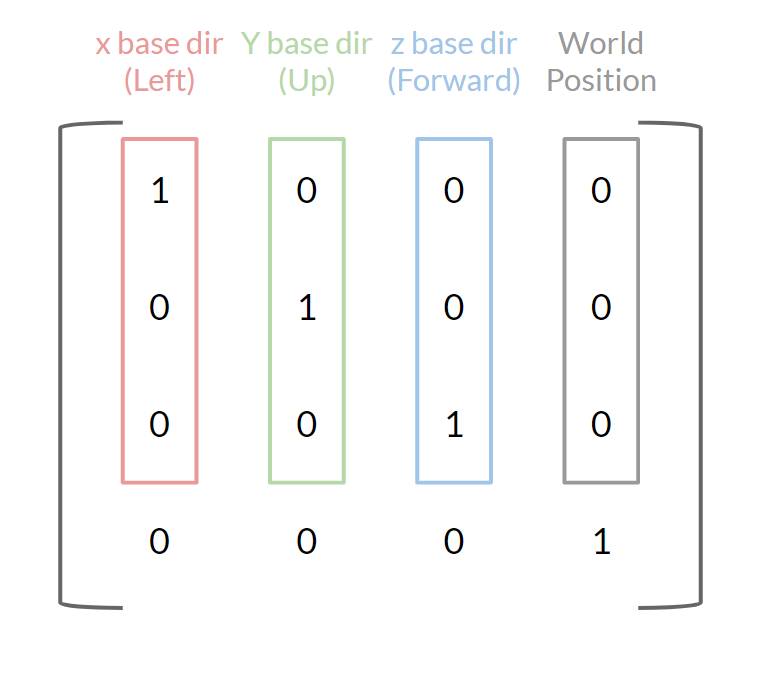
The Conventions To Respect¶
In 3D math, we have the boon (or bane?) to arbitrarily define and follow two conventions that are capable of making a huge difference in the code base: the handedness of our coordinate system, and whether or not we represent vectors as row vector or column vector. They don't change the underlying mathematical meaning of things, but we need to be aware of them to make things right.
Handedness¶
The handedness defines where the world basis vectors are pointing to, and affects the result of vector cross product. In a left-handed coordinate, the x-axis points to the right of the screen, y points up, and z points into the screen. Using your left hand, your pointer finger points in the direction of x (to the right of the screen), your middle finger points in y (to the top of the screen), then your thumb points into the screen. Well, on the other hand (literally!), keeping your index and middle fingers pointing in the same directions your thumb will point in the direction of the screen. By rotating your index to point to the left of the screen, rather than the right, your thumb (z-axis) now points into the screen again. See image below for a visualization.
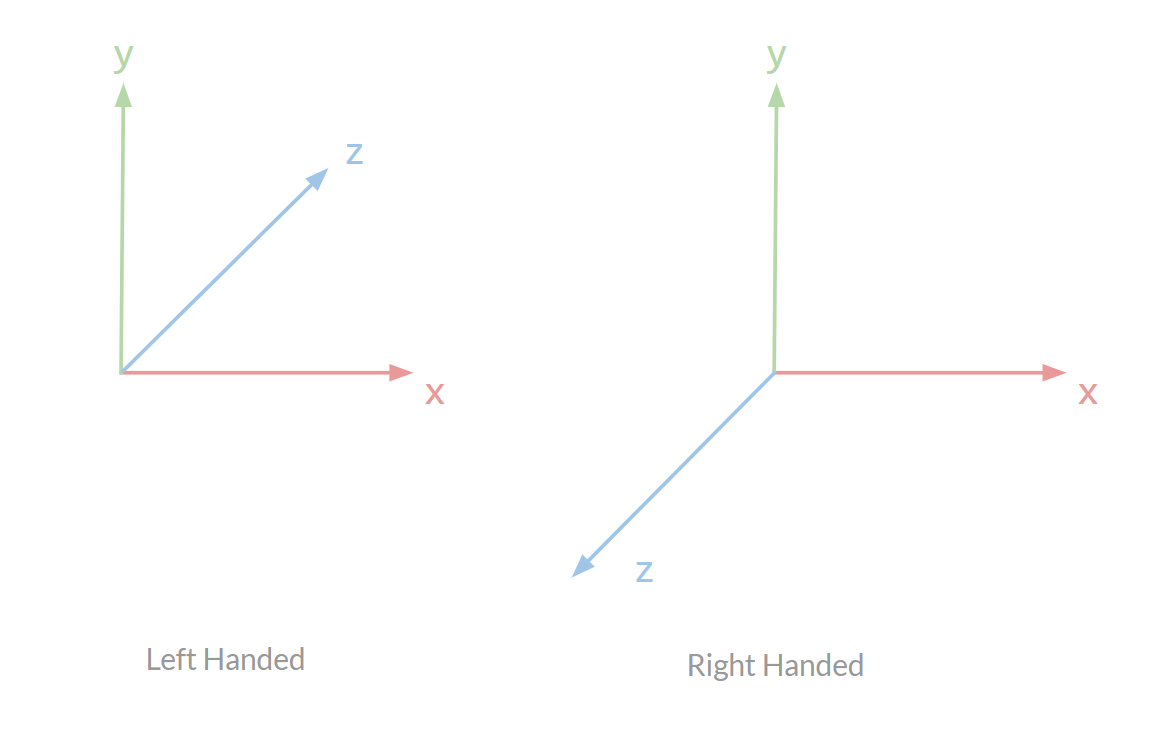
This convention also has implications on our gameplay code. In local space, let's define the z vector to be the forward vector, and the y vector to be the up vector. In a left-handed coordinate, the x vector will turn out to be the right vector. While in a right-handed coordinate, the x vector will be the left vector. This is why in the last section we said the first three elements of the matrix's first column is the left vector - it's always "the x vector", but the "left" or "right" is some meaning we impose on it.
Column/Row Vector¶
This is another convention we can arbitrarily define and follow and call it a day. The difference is that when we are multiplying a matrix and a vector together, we're not sure how to represent the vector in matrix form. We can either represent it with a 1xn matrix known as row vector or nx1 matrix known as column vector.
This decision will impact which side of the equation we put the vector on when we multiply it with a 4x4 matrix. Recall that the multiplication between matrix A and matrix B is only defined when A's number of rows is equal to B's number of columns. Thus, column vector goes left while row vector goes right.

Furthermore, this convention changes how we store data in a matrix. For example, for the elements that represent translation in a Matrix4 to be picked up properly during multiplication, they need to be put on the fourth row if we are using row vectors, and on the fourth column if we are using column vectors. You can do a multiplication manually to prove this. This is also why in an earlier section we explained how the first three elements of each column carry some meaning (base vector directions, and translation). If we choose to use column vectors, their meaning would change, as shown in the picture below.
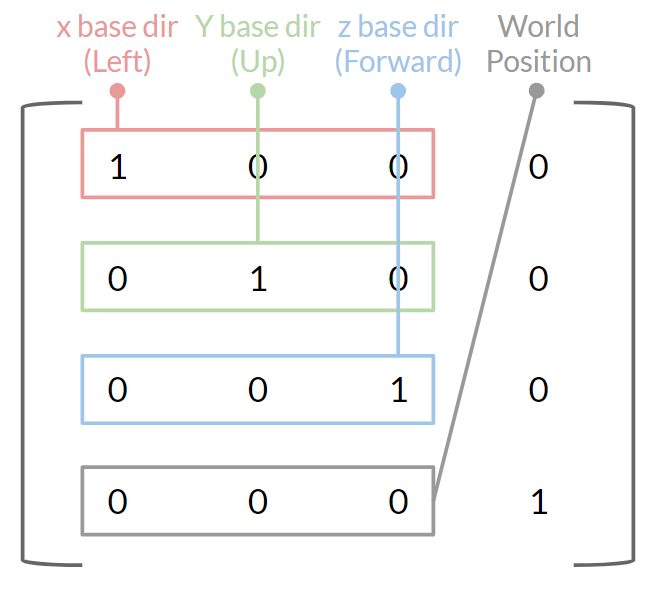
Another implied impact would be how we chain matrix multiplication together. If using row vector, matrix should be chained in the order in which transformations are applied, i.e., if we do Transformation #1 first, then Transformation #2 and Transformation #3, the way we express that in formula is V x M1 x M2 x M3. While it's the opposite way if using column vector, which would be M3 x M2 x M1 x V.
The Dirty Flag¶
This section is about optimization rather than functionality. Dirty flag is trying to solve two problems with transformations:
- We need objects' latest "local to world" matrices every time we render those objects. To keep those matrices up-to-date, we can simply recalculate them every time we need them. But the recalculation can be expensive, especially when the object has a parent as it involves matrix multiplication. Also, a lot of the objects in the scene don't move at all or very seldom during their lifetime, like walls and terrains. Therefore, recalculating matrices every time can be a huge performance waste.
- Components of the matrix, like local position, local rotation, and local scale, may be updated very frequently, but the world matrix may be needed once a frame. For example, a developer can modify an object's local position, scale, and rotation in a single
Updatefunction, but theRenderUpdateonly needs it once when it tries to draw the object. Therefore, if we recalculate the matrix everytime something changed, we may end up doing useless work (the matrix is only needed once but we recalculated it three times, the cost could be worse if doing multiple local updates in a frame).
To solve these problems, we can introduce a "dirty flag" (which is simply a bool variable). The flag is set to dirty when something local is changed and the matrix needs to be updated. When the matrix is needed, if the dirty flag is set, it will perform the recalculation and clear the flag, otherwise just grab the matrix—the fact that the dirty flag is not set implies that the matrix is up-to-date.
By doing this, the matrix of those non-movable objects would only be calculated once in their lifetime versus calculated every frame. This can bring us a big performance boost. But the downside is that we need to keep a Matrix4 on each instance of the transform class, which obviously increases our memory usage.
For a more in-depth view of dirty flag, you can read the chapter on it from the Game Programming Patterns.
We had a stupid bug with dirty flags in the following code (modified for better display), can you spot it?
void Transform::SetParent(Transform* transform) {
if (parent == transform) return;
if (parent != nullptr) parent->RemoveChild(this);
if (transform != nullptr) transform->AddChild(this);
parent = transform;
isDirty = true;
}
Only this transform's isDirty flag is set to true, while its children's are not! When you set the parent of an object, its children's matrices will also become outdated, cause their hierarchy changed! So, what we should do instead, is something like this:
ForSelfAndDescendents([](Transform* trans) { trans->isDirty = true; });
The One Who Owns All Children¶
We had a discussion (well, more like a war) on who should keep track of the hierarchy—the Entity, or the Transform. The reason for letting Entity keep it is that the Entity needs functions like GetComponentsInChildren and GetComponentsInParent. The reason for letting Transform keep it is that it needs the hierarchy information more frequently as they are calculating matrices, and the Entity should really just keep a bunch of different components (including the Transform) and let the components bring functionalities.
For now, we decided to let the Transform class have it. This might be a wrong decision, but we'll figure that out down the line.
There is actually another argument involved in this: Should the
Transformclass be just a data class? As in, it would just hold the data but not provide any functionality, and theEntityclass would handle the functionality. This approach is actually adopted by CryEngine, but we decided to letTransformalso hold the functionality. We really don't have a super strong reason for this, other than "the entity should just be a component container". It's more like a philosophy question.
The Small Step!¶
We implemented a fly camera control with our component and transform system, for both demoing and testing (and of course it's super buggy!). Here is what we got (the gif is motion-sick prone, watch with caution)!
That's all from Transform this week. We will spend the next week debugging and adding to it when we discover missing features.
DLL¶
So before this point, it might be fair to say we didn't really have an engine because all of our tests and code was hardcoded into the engine. With the scene graph (Level and Transform) updates to our engine, we are technically ready to start building a game! We could continue to build within the engine, but that doesn't seem like any fun. Instead, we want to make a DLL; that way, other people can just use the engine's DLL without needing to modify the engine source code.
To build a DLL was fairly straightforward, we created a new configuration strictly for the DLL because we wanted to be able to still run/debug the engine from within the engine project without having to switch to the game project. Then within the engine, we defined a macro to export specific functions to dll which import the functions with the DLL. The only snag was with regards to starting the engine: The EngineLoop variable needs to be declared and the Run function must be called. So although the developer can declare variables and classes prior to calling Run, there is no way to hook those declarations into the engine, so we are fine with this for now.
The game development can now officially begin in a separate project to the engine, but there is the added benefit that this also lets us start having more persistent test harnesses20 (labeled IsettaTestbed within our engine). The tests can occur in different levels thus don't need to be removed to keep the main scene from becoming cluttered. Although this will be useful, there is a catch similar to how we had to go back and add comments to our code. We need to go back and add our new macro to all of the public functions that we want to be usable and exposed to the game developer! So in all honesty, the testbed is not ready to be tested in quite yet.
Patch Notes¶
Unit Testing Just Got a Bigger "Unit"¶
This week, we decided to run our unit tests once again.
...two weeks after the last time. You might be able to guess the results:
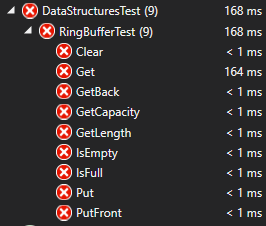
After some digging, we found that the failures were not because we're terrible engineers and broke an entire module, but rather that every unit test attempted to do something it could not: use the game engine. Particularly, we've begun refactoring all engine code to use its own utilities like memory, so for us to run unit tests on it, we need to run the engine first.
We quickly looked online for a solution, and found that you can indeed run some code before each testing module by using the TEST_MODULE_INITIALIZE macro from the CppUnitTestFramework namespace. Our fix is literally about 30 lines:
#include "CppUnitTest.h"
#include "EngineLoop.h"
using namespace Microsoft::VisualStudio::CppUnitTestFramework;
namespace Isetta {
class TestInitialization {
public:
TestInitialization();
static void TestClassInitialize() { engineLoop.StartUp(); };
static void TestClassCleanup() { engineLoop.ShutDown(); };
private:
static EngineLoop engineLoop;
};
TestInitialization::TestInitialization(){};
EngineLoop TestInitialization::engineLoop;
TEST_MODULE_INITIALIZE(ModuleInitialize) {
TestInitialization::TestClassInitialize();
}
TEST_MODULE_CLEANUP(ModuleCleanup) {
TestInitialization::TestClassCleanup();
}
} // namespace Isetta
Once that was added, we ran the tests again and got flying colors!
Unfortunately, this has left some heavy implications. From here on out, our unit tests will be dependent on the engine running beneath them unless we spent a lot of time on separating out that code. And because we use the engine, we need to bring in all of our engine code into the unit testing project, which can be a headache to maintain when we rename and move things around.
As a result, we've decided to leave unit testing for something to consider further down the project timeline if we want to try it at all during the 15-week period. We'll still be developing testing harnesses to make sure our engine features don't regress, but a unit testing system is beginning to require an investment that we just can't provide.
Hey, at least our current tests still pass! The jury may still be out on us not being terrible programmers, though...
Coming Soon¶
This week we released our conversation with Alice Ching of Funomena as well as the great advice she was able to give to us! We interviewed Aras Pranckevičius (@aras_p) from Unity's build team (as well as many other accomplishments) this week, and had a great talk about Unity's history and evolution.
Resources¶
There were lots of great resources gathered this week that we've chronicled on our resource page. If you're building your own engine and have deeper burning questions you may want to start there!
Originally Published October 12, 2018.
-
OpenGL is an open source graphics library for rendering 2D and 3D vector graphics. ↩
-
Qt is a framework for creating retained GUI applications. ↩
-
A viewport is the "window" which the camera will render content to the screen, it is specified with an (x,y) offset from the top-left in OpenGL and a width and height. ↩
-
Vertex arrays and buffers hold the vertex information such as vertex positions, normals, color, etc and are stored within the OpenGL state. ↩
-
Element buffers hold additional information regarding the vertices, specifically what index the pertinent information is located within the vertex array. ↩
-
Culling is the early rejection of objects being passed through the render pipeline, because they don't contribute to the final image. ↩
-
Model-view matrix refers to the matrix which transforms a position in local space to world space, then to camera space. ↩
-
The transpose of a matrix is when the entries on the diagonals are flipped about the center diagonal. ↩
-
A vertex shader is a graphics program that alters information associated to the vertices, it is one of the first stages in the graphics pipeline. ↩
-
Homogeneous coordinates differentiate points from vectors by expanding the traditional
Vector3to aVector4and placing a 0 in the 4th element for vectors and 1 in the 4th element for points. ↩ -
Frustum is the portion of the world which is viewable by a camera. It is typically shaped like a pyramid with near and far planes clipping the volume. What is rendered is the volume between the 2 planes. ↩
-
Pivot refers to the local position of the model which is the zero position. When transforming the model in the world space, all changes are relative to this point. An offset pivot is when the pivot is placed in a position that isn't about the model, for example offset in
X=100from the model. ↩ -
.geo files are Horde3D's processed file for model and animations, optimized for more efficient rendering. The file is processed through the Horde3DUtil library and done prior to runtime. ↩
-
In C++, a union is a special class type that can hold only one of its non-static data members at a time. Similar to a struct, you can declare multiple variables in a union, but only one is available at the same time. Another distinction is that the size of a struct is the sum of all of its members, but the size of a union is the size of the biggest member. The way the author understands it is that union gives you different ways to interpret the same memory values. ↩
-
Every Matrix4 has 16 numbers is it, and the 16 numbers are usually stored in a big array in a specific order. Column-major and row-major are two different orders of storing them. In Column-row matrices, numbers are put in the array "column by column", i.e., the 4 numbers in the first column occupy the first 4 slots in the array. While row-column matrices store them "row by row" - the first 4 slots in the array correspond to the first row in the matrix. ↩↩↩↩
-
In Object Oriented Programming, object composition is a way to combine simple objects or data types into more complex ones. The Component pattern in Game Programming Patterns book describes this in detail. ↩
-
RTTI stands for Runtime type information, which is a language feature that exposes information about an object's data type at runtime. For example, if you want to get the type name of some object as
string, you would need RTTI. ↩ -
Macros are a way of automatically substituting text for some other during the compiling process. In C++, they are defined as
#define TEXT_IN_CODE TEXT_TO_COPY OVER. For example, if you define#define SPEED 5and writemySpeed = SPEED, SPEED will be substituted by 5 during compile time and the compiler will actually seemySpeed = 5. ↩ -
Oracle is a computer technology corporation headquartered in Redwood Shores, California, who acquired Java from Sun Microsystems and is now maintaining it. ↩
-
Test harnesses is a test framework which can ensure the progression of the software. In the Isetta Engine case, they will act as sample levels to demo features of the engine and as versioning happens to ensure old features aren't broken on accident. ↩

